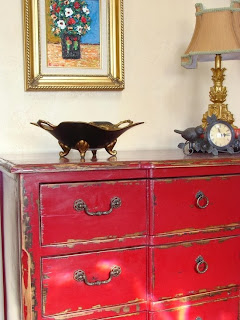

A lot of ppl are nervous about how to distress, how much to distress, or even if they should distress.
The first questions is how ... there are many different methods and tools that you can use but the
simplest and easiest to understand is sand paper. When I sand I use 80 (course) 120 (medium) 220 (smoother).

**The following information applies to sanding ASCPs.**
220 (smoother) can smooth out a finish, remove drips, and do some light edge distressing.
120 (medium) removes paint quicker and in larger sections.
80 (course) is very aggressive and should be used with great caution.

The first place to sand is your edges, this defines the shape of your project.
Secondly consider where natural wear is, like hands always touching the drawer pull.

I distressed this piece to match an inspiration photo I have (source unknown). Be aware that too much
flat surface distressing is not desirable and always keep your sand paper moving in the direction
of the grain. Natural wear spots are made when the surface has been rubbed over time and in turn the wood grain shows. If you start crossing the grain with your sand paper it will look like a hack job.





0 komentar:
Posting Komentar